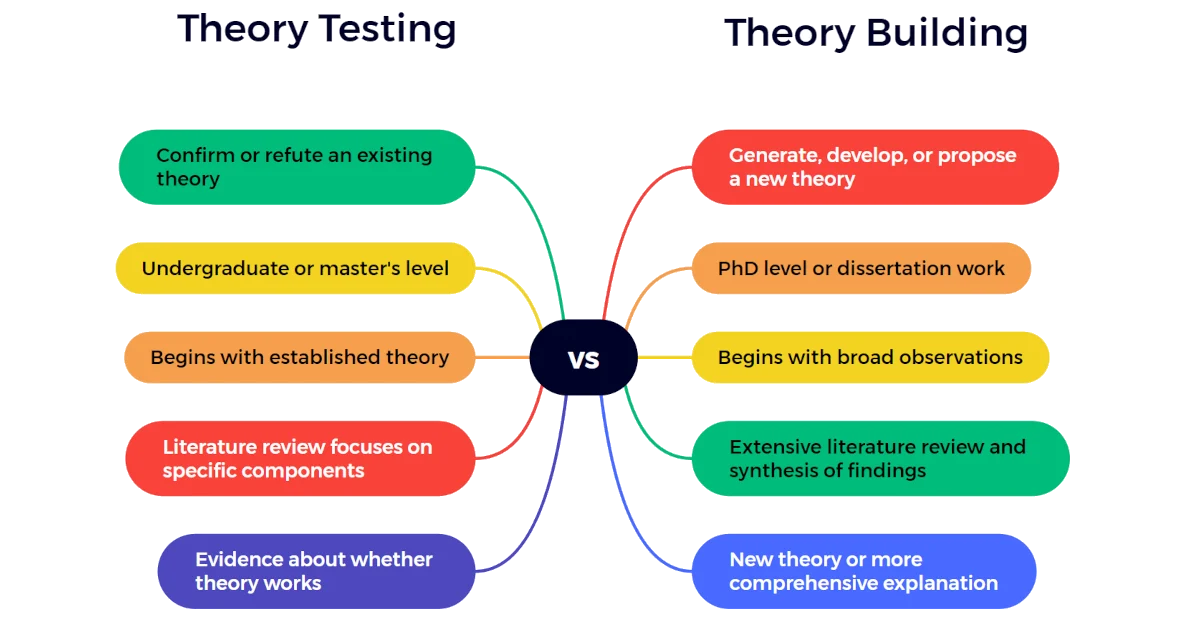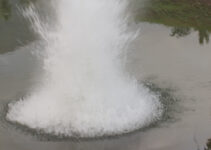Updated | September 23, 2025

What is the difference between theory testing and theory building? This article sheds light on the issue as one of the concerns of advanced higher education.
Essentially, what do graduate students do when they conduct a research investigation? Do they follow specific guidelines in doing their research? Is there a difference between how a master’s degree and a doctoral degree student do their research? What are theory testing and theory building? The following article answers these questions.
Graduate students research two different ways. A master’s degree student engages himself mainly in research primarily aimed towards theory testing, while a doctoral degree student undertakes a much more challenging research task of theory building. What is the difference between theory testing and theory building?
Table of Contents
Theory Testing and Example
Theory testing is relatively easier than theory building. The graduate student primarily applied theory testing, as the name suggests, to test whether a particular theory of his choosing is a plausible explanation for a phenomenon he would like to investigate. This article discusses the difference between theory testing and theory building.
To clarify the concept of theory testing, take the case of the Anthropogenic Global Warming (AGW) Theory. Anthropogenic refers to human-derived greenhouse gas emissions believed to be the main reason for the observed global warming in recent years.
Carbon dioxide comprises one of the greenhouse gasses. Carbon dioxide causes water on the surface of the earth to evaporate. Increased water vapor in the atmosphere can trap heat coming from the planet, thus causing global warming. Is this a good explanation for global warming?
If you are a master’s degree student, you can test the global warming theory by looking into the humidity levels associated with carbon dioxide emissions. That is because it was mentioned a while ago that carbon dioxide causes the water to evaporate. More significant carbon dioxide means more water vapor in the atmosphere measured using a wet and dry bulb thermometer. You will then have to find out if there is a correlation between temperature and surface humidity. This tests theory using specific factors to substantiate carbon dioxide effects on global temperature.
The focus of theory testing is to find evidence to confirm or refute a theory. In this instance, theory testing tries to find out if there is there sufficient evidence to substantiate the Anthropogenic Global Warming Theory.
Theory Building and Examples
Theory building in research requires the application of higher-level critical thinking skills compared to theory testing. Doctoral degree students or dissertation writers engage in this kind of research.
Why is this so? I expound some more on the difference between theory building and theory testing as activities of graduate students in the next sections.
Synthesis of Literature
Theory building requires the synthesis of a broad range of literature and studies to provide evidence or confirm explanations for a given phenomenon. Theory building is the graduate student’s or a veteran scientist’s attempt to explain something plausibly in a different light or perspective.
Take the case of areas that get inundated by seawater due to sea-level rise. How do coastal communities respond?
One of the coastal community responses to sea-level rise due to climate change is to build seawalls. This adaptation prevents coastal erosion as a result of advancing waters. This measure, however, could prove futile as this picture shows.

To further clarify the idea of theory building, take the previously discussed theory that tries to explain global warming, that is, the Anthropogenic Global Warming (AGW) Theory. The AGW Theory is just one theory that tries to explain global warming.
Six Other Theories on Climate Change
Bast (2010) enumerated six other theories on global warming. I list these theories below:
1. Biothermostat Theory
The theory proposes that negative feedback from biological and chemical processes on Earth offset negative feedback caused by increasing carbon dioxide levels.
2. Cloud Formation and Albedo Theory
The theory advances the idea that changes in the formation and albedo (the proportion of light reflected by a surface) of clouds cancels all or nearly all the warming effects of greater levels of carbon dioxide.
3. Human Forcings Besides Greenhouse Gases Theory
The theory postulates that man influences climate is not only because of greenhouse gas emissions but likewise important human activities like clearing forests, irrigating deserts, and building cities.
4. Ocean Currents Theory
The theory explains that the variation of temperature worldwide was due to the slow-down of Thermohaline Circulation (a large-scale circulation of the ocean driven by differences in density due to changes in temperature and freshwater input) of the ocean.
5. Planetary Motion Theory
The theory attributes the recent global warming phenomenon to natural gravitational and magnetic oscillations of the solar system.
6. Solar Variability Theory
The theory suggests that global warming is due to changes in the sun’s brightness caused by bursts of energetic particles and radiation that periodically vary.
These are all theories that try to explain global warming. The graduate student needs to read a great deal of literature and gain insights to build theories. Further, you must note that these theories are not perfect explanations of global warming. Some of these theories may be substantiated or confirmed through time. On the other hand, further theory testing will show their weaknesses.
Whichever of these theories will stand rigorous scrutiny by researchers through further studies on global warming causes will come out as the best theory of global warming. That’s how science works.
Key Differences Between Theory Testing and Theory Building
Based on the previous discussion, I sum up the key differences between Theory Testing and Theory Building in the table below.
| Aspect | Theory Testing | Theory Building |
|---|---|---|
| Purpose / Goal | To confirm or refute an existing theory; to examine how well a theory applies given data. | To generate, develop, or propose a new theory; to offer a plausible explanation of phenomena, especially where existing theories are insufficient. |
| Difficulty / Level | Relatively easier. Often undergraduate or master’s-level research. | More challenging, requiring deeper thinking and synthesis. Usually PhD / dissertation work. |
| Starting Point | Begins with an established theory. The researcher takes that theory and tests specific hypotheses derived from it. | Begins with broad observations or gaps in the literature; synthesizing multiple studies, perspectives, and theories to propose a new or revised explanatory framework. |
| Required Literature Engagement | Needs literature review so you know what existing theories say; but focus is narrower, on specific components or hypotheses. | Requires a more extensive literature synthesis: many theories/studies, alternative explanations, etc., to build something new. |
| Outcome / Output | Evidence about whether the theory works (support/refute/corroborate). Perhaps refinement or modification, but more confirmatory. | New theory or at least a more comprehensive explanation; may point out new angles or perspectives; can generate testable hypotheses later. |
| Examples | Testing “Anthropogenic Global Warming (AGW)” by seeing if higher CO₂ correlates with higher humidity, etc. | Proposing alternate theories or additional theories of climate change (e.g. Cloud Formation & Albedo, Solar Variability, etc.) to explain the phenomenon; or seeing how coastal communities adapt to sea-level rise. |
Conclusion
Theory testing and theory building serve complementary roles in advancing knowledge. Theory testing focuses on examining the validity of existing explanations by confirming or challenging their applicability to observed data, making it a more straightforward endeavor often undertaken in undergraduate or master’s research.
In contrast, theory building requires a higher level of intellectual synthesis, drawing from diverse studies and perspectives to create new frameworks that account for phenomena not fully explained by current theories—an endeavor usually reserved for advanced doctoral research. Together, these processes ensure that scientific understanding is continually refined, expanded, and enriched.
Reference
Bast, J. L. (2010). Seven theories of climate change. Chicago: The Heartland Institute. 30 pp.
FAQ: Difference Between Theory Testing and Theory Building
Q1: What is theory testing in research?
Theory testing is the process of confirming or refuting an existing theory by examining evidence that supports or contradicts it. Master’s degree students often engage in theory testing because it is relatively easier and focuses on applying existing frameworks.
Q2: What is theory building in research?
Theory building involves creating or developing new theories to explain phenomena that are not fully addressed by existing theories. It requires higher-level critical thinking, extensive literature synthesis, and is often undertaken at the doctoral level.
Q3: How does theory testing differ from theory building?
Theory testing begins with an established theory and investigates its validity using data, while theory building starts from observations or literature gaps to propose new explanations. Testing is confirmatory, whereas building is generative.
Q4: Who typically conducts theory testing vs. theory building?
Master’s students typically conduct theory testing, while doctoral students and advanced researchers usually engage in theory building, given its complexity and demand for original contribution.
Q5: Can theory testing and theory building complement each other?
Yes. Theory testing provides evidence to support or challenge existing theories, while theory building expands knowledge by proposing new frameworks. Together, they ensure continuous scientific progress.




thanks a lot!!
Hello dear, i found this article very interesting. I was in search theory-lead and non-theory -led research information. So, could you please share me some points about theory-led and non-theory-led researches and their meaning.
Dear author
The article is so informative and simple. Can I get a more detailed description about this topic – “testing theories and generating theories”.
Dear Athira,
Thank you for visiting Simplyeducate.me. When you would like to test theories, you need to know first what existing theories there are on your given subject. Therefore, this requires you too review literature. Upon doing so, you will be able to generate your own theory, i.e., if you are well equipped to do it. The convention, as this article suggests, is that PhD students do this since they have already been through the testing theories stage. They generate their own theories to explain a phenomenon.